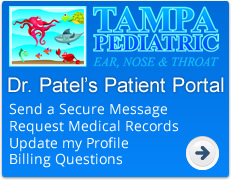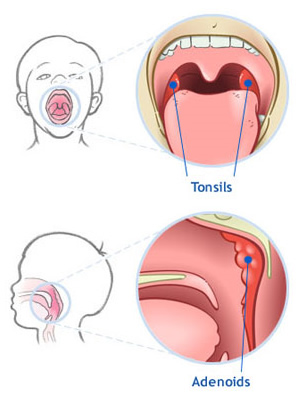|
|
 |
|||||||||
Tonsillectomy & Adenoidectomy
AnatomyThe tonsils are glands located on both sides of the back of the mouth. The tonsils are part of the immune system and help fight infections. The adenoids are located behind the soft palate. The soft palate is the back, muscular part of the roof of the mouth. The adenoids are also part of the immune system and help fight infections. The uvula is also located in the back of the mouth. It dangles down from the middle of the soft palate. Behind the uvula, there is a passageway that connects the nose to the mouth. The eustachian tubes connect the middle ear to the back of the nose. These tubes prevent the pressure inside the ear from changing too much. Swelling and inflamation around the adenoids can cause blockage of the eustachian tubes. If the eustachian tubes get clogged, the middle ear could fill up with pus and cause middle ear infections or inflamation. This can sometimes lead to hearing loss. Symptoms & CausesThe most common reason that a tonsillectomy is preformed is due to repeated tonsillitis. Tonsillitis is considered to be chronic or dangerous if there have been:
The tonsils may get large enough to touch each other. When this happens, it is known as "kissing tonsils". Another reason for a tonsillectomy is an abscess surrounding the tonsils. An abscess is a pus-filled sac. This rarely happens, but is a reason for a tonsillectomy. Repeated middle ear infections in young children, due to swollen adenoids and clogged eustachian tubes, can lead to hearing loss. Sometimes hearing loss can cause speech problems. An adenoidectomy may be performed to help prevent middle ear infections. Diagnosis & Treatment
If antibiotics do not work to eliminate tonsillitis or ear infection, a tonsillectomy and possible adenoidectomy may be performed. These operations help to reduce the number of throat and middle ear infections. Before a T&A, the doctor may request a blood test to find out:
Blood tests can help the doctor make sure that there will not be too much bleeding after surgery. The mouth area tends to bleed more than othe areas of the body; if blood cannot clot properly or if the platelet count is low, there is a higher risk of bleeding too much. Coblation® TonsillectomyA better overall experiencePatients report a better overall experience with Coblation-assisted tonsillectomy after surgery compared to traditional procedures such as electrocautery and cold knife. Studies show that patient calls and visits to the doctor due to complications after surgery are significantly less with Coblation-assisted tonsillectomy. Coblation® tonsillectomy and adenoidectomy is a gentle procedure for removing both tonsils and Traditional methods remove tonsils and adenoids by cutting or burning, which can cause extensive pain and damage to surrounding healthy tissue. Coblation is an advanced technology that combines gentle radiofrequency energy with a natural salt solution to quickly and safely remove tonsils and adenoids. Because traditional procedures use high levels of heat to remove the tonsils and adenoids, damage to surrounding healthy tissue is common. Coblation does not remove the tonsils or adenoids by heating or burning, leaving the healthy tissue surrounding the tonsils unaffected. The innovative approach of Coblation results in minimal pain and rapid recovery for patients. Why Coblation Tonsillectomy?You may remember your childhood tonsillectomy as a painful experience. Your child may not have to repeat that experience. Now, physicians' use of advanced cool-temperature technologies, like Coblation®, for tonsillectomy means that your child can experience less pain after the procedure, with a faster return to a regular diet and normal activity. Patients report a better overall experience with Coblation-assisted tonsillectomy after surgery compared to traditional procedures such as electrocautery and cold knife. Studies show that patient calls and visits to the doctor due to complications after surgery are significantly less with Coblation-assisted tonsillectomy. Faster recoveryBecause of tissue damage caused by traditional tonsillectomy procedures, patients often take up to two weeks to return to a normal diet and resume normal activities. Coblation-assisted tonsillectomy is the gentle alternative, offering a rapid recovery and minimal pain. With Coblation-assisted tonsillectomy, most patients resume a normal diet and activities within a few days. Coblation-assisted tonsillectomy received FDA clearance in 2001. T&A ProcedureThe T&A is performed under general anestheria, which means the patient is asleep during surgery. The surgeon removes the tonsils and possibly the adenoids in one of several ways. If you need a T&A, your surgeon can discuss which method he or she will use; one is not better than another. When the surgeon is done, bleeding is stopped and the patient is taken to the recovery area. After surgery, in the recovery area, the patient is allowed to wake up. He or she is given medications to reduce pain and swelling. When the patient has recovered from surgery, they are able to go home. It is important that someone else drives the patient home because it would be unsafe for the patient to drive. After The SurgeryT&A is a very well tolerated operation. A sore throat is normal after the operation. It is important to watch for bleeding after a tonsillectomy. If the patient swallows a lot, the surgical site may be bleeding; it is important to check inside the mouth often for the first few days. It is easiest to swallow liquids and cold desserts at first. It is important to drink a lot, even if it hurts to swallow because otherwise, the patient could become dehydrated. Children will usually have a sore throat for about 1 week after surgery; adults tend to have a sore throat for about 2 weeks following surgery.
|
| © Tampa Ear, Nose & Throat Associates | Otolaryngology | 3000 Medical Park Drive, Suite 200, Tampa, FL 33613 | Disclaimer Privacy & Terms of Use Meet Our Staff | Our ENT Specialties | Conditions & Treatments | Referring Physicians | For Patients | Video Education & News | Appointments & Locations Allergies | Larynx Voice | Nose & Sinus | Office Based Procedures | Pediatric ENT | Snoring & Sleep Apnea Advanced Technology | Cerumen Removal | Septoplasty | Sinusitis | Swimmers Ear | Tinnitus | Tonsils & Adenoids | Vertigo | Thyroid & Parathyroid Powered by MedCoData |

 A tonsillectomy and possible adenoidectomy is a very common and safe operation. It is the second most common surgery performed on children; however, sometimes it is necessary for adults as well. Tonsillectomy and adenoidectomy, or T&A, can help to prevent frequent sore throats and may also help decrease the chances of middle ear infections. A tonsillectomy and adenoidectomy are not always performed together; only one or the other may be needed.
A tonsillectomy and possible adenoidectomy is a very common and safe operation. It is the second most common surgery performed on children; however, sometimes it is necessary for adults as well. Tonsillectomy and adenoidectomy, or T&A, can help to prevent frequent sore throats and may also help decrease the chances of middle ear infections. A tonsillectomy and adenoidectomy are not always performed together; only one or the other may be needed.
 adenoids offering a fast and easy recovery.
adenoids offering a fast and easy recovery.